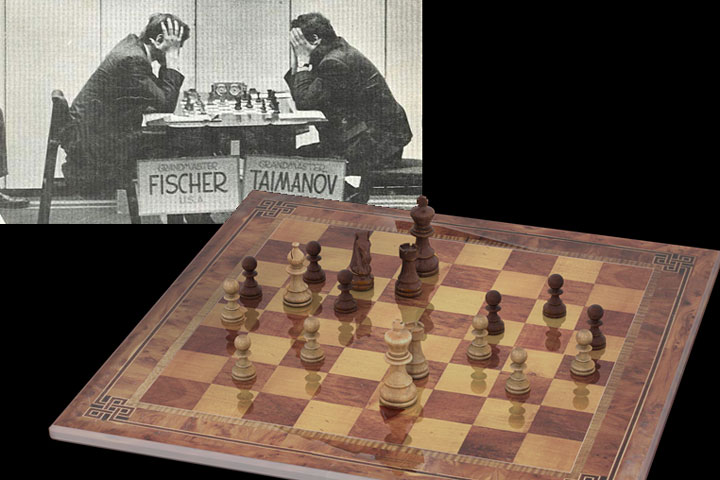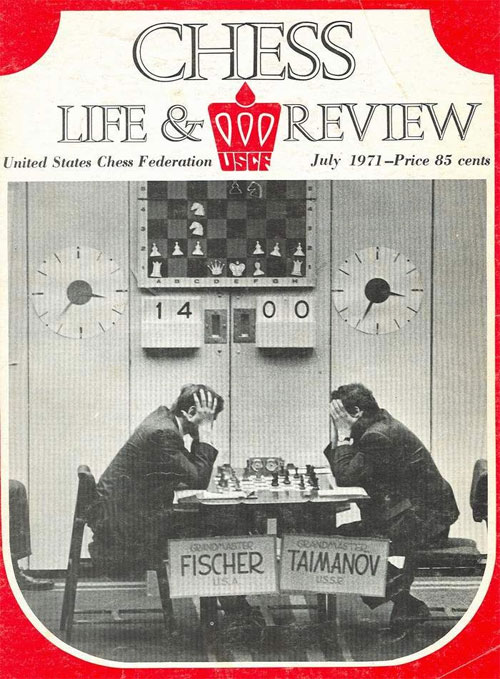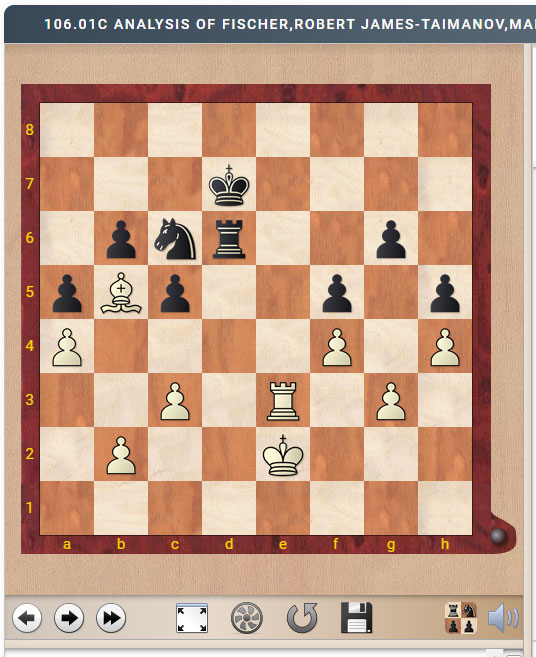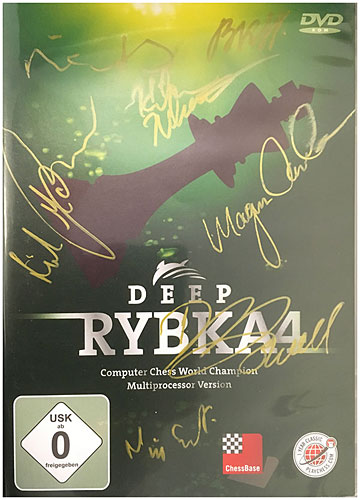


 Five months after the Palma de Mallorca Interzonal (1970) qualifier, the quarterfinals of the Candidates Matches were held. American GM Bobby Fischer faced the experienced Soviet star Mark Taimanov in a ten-game match, which was held in in Vancouver, Canada.
Five months after the Palma de Mallorca Interzonal (1970) qualifier, the quarterfinals of the Candidates Matches were held. American GM Bobby Fischer faced the experienced Soviet star Mark Taimanov in a ten-game match, which was held in in Vancouver, Canada.
The first game was a very tense fight, but Taimanov was shaken by a mistake on his 36th move. The second game was adjourned several times in drawn positions. But after losing the third game due to a mistake in the 20th move, which continued to haunt him for days and nights to come, Taimanov also lost the dead-drawn adjournment of the second game, and so he was already shaken when the fourth game started.
Later Taimanov said: "Until the match with Fischer in 1971, everything went smoothly in my chess career. This dramatic match changed my life into hell. The sanctions from the Soviet government were severe. I was deprived of my civil rights, my salary was taken away from me, I was prohibited from travelling abroad and censored in the press. It was unthinkable for the authorities that a Soviet grandmaster could lose in such a way to an American, without a political explanation. I therefore became the object of slander".
The adjournment of game four was a great disappointment for the Soviet grandmaster. But the position remains a mysterious riddle even today. What had the mighty Soviet analysts missed that led to the mistake 42...Kd8? Was the adjourned position not lost?
When preparing for the presentation of the book Bobby Fischer, The Career and Complete Games of the American World Chess Champion in the Max Euwe Center in Amsterdam, I had to select a few positions to show the audience. One I used was the following famous classic, with the typical material constellation for the Fischer endgame — rook and strong bishop vs rook and knight:
Endgame literature generally considers this position to be already lost for Black, but Charles Sullivan had drawn my attention to an interesting defensive try. Instead of the game move 42...Kd8? allowing the exchange of rooks, when White's king will penetrate slowly but surely by using the sharp endgame weapon zugzwang again and again, Andrew Soltis had suggested 42...Rf6.

[Event "Candidates qf Fischer-Taimanov +6-0=0"] [Site "Vancouver"] [Date "1971.05.25"] [Round "4"] [White "Fischer, Robert James"] [Black "Taimanov, Mark E"] [Result "1-0"] [ECO "B47"] [Annotator "Mueller,Karsten"] [SetUp "1"] [FEN "8/3k4/1pn2rp1/pBp2p1p/P4P1P/2P1RKP1/1P6/8 b - - 0 41"] [PlyCount "60"] [EventDate "1971.05.16"] [EventType "match"] [EventRounds "6"] [EventCountry "CAN"] [SourceTitle "ChessBase Website"] [Source "ChessBase"] [SourceDate "1999.07.01"] [SourceVersion "2"] [SourceVersionDate "1999.07.01"] [SourceQuality "1"] {The old riddle of Fischer vs Taimanov The endgame of the 4th game of the famous candidates match Vancouver 1971 is very instructive. But one question has remained puzzling. Was the adjourned position already lost or was Taimanov's 42th move a decisive mistake?} 41... Rd6 {The sealed move} 42. Ke2 Kd8 $2 {Now it should definitely be lost. At least the sources agree here on this verdict. It is difficult to say, what the Soviet analysts had overlooked in their analysis of the adjourned position.} ({Later Andrew Soltis claimed in Bobby Fischer Rediscovered that the defence} 42... Rf6 {should have been played with good drawing chances. But I think that White wins in any case.}) 43. Rd3 $1 {Without rooks Fischer had proved a win in his adjournment analysis. } Kc7 44. Rxd6 Kxd6 45. Kd3 Ne7 46. Be8 Kd5 47. Bf7+ Kd6 48. Kc4 Kc6 49. Be8+ Kb7 50. Kb5 Nc8 51. Bc6+ Kc7 52. Bd5 Ne7 53. Bf7 Kb7 54. Bb3 Ka7 55. Bd1 Kb7 56. Bf3+ Kc7 57. Ka6 Nc8 58. Bd5 Ne7 59. Bc4 Nc6 60. Bf7 Ne7 61. Be8 Kd8 62. Bxg6 Nxg6 63. Kxb6 Kd7 64. Kxc5 Ne7 65. b4 axb4 66. cxb4 Nc8 67. a5 Nd6 68. b5 Ne4+ 69. Kb6 Kc8 70. Kc6 Kb8 71. b6 {So the challenge is: I claim that the position after 42.Ke2 is won for White in any case and I ask readers to send winning proofs. But of course drawing proofs can also be sent and if readers find a draw after the game continuation 42....Kd8? that would be extremely interesting as I am convinced that without rooks it is a clear win for White. With rooks it is a borderline case even for the modern engines.} 1-0
This is where we want to enlist your help. Does Andrew Soltis new defence 42...Rf6 draw or can you show a winning line for White? Is the adjourned position already lost? What had the Soviet analysts missed? Did Bobby prove a win after the rook exchange (after 43.Rd3)?
I am interested to see if a reader will create a major sensation by finding a drawing proof after the rook exchange. But of course the most intriguing question is whether the adjourned position was already lost in all cases or not. This is still a borderline question even for the modern engines, and I am curious if a drawing proof or a winning proof will win the analysis competition.
By the way: I think that the adjourned position is won anyway, but of course I am not 100% sure. So I need your help!
 You probably know that in our replay boards there are a large number of functions you can use to really appreciate the games. Recently we published a comprehensive tutorial on how to get the most out of the live broadcast game viewer. Learn about all the powerful features and buttons that make the ChessBase's replay one of the best watching experiences around.
You probably know that in our replay boards there are a large number of functions you can use to really appreciate the games. Recently we published a comprehensive tutorial on how to get the most out of the live broadcast game viewer. Learn about all the powerful features and buttons that make the ChessBase's replay one of the best watching experiences around.
One big advantage is that you can start an engine (fan icon) that will help you to analyse. You can get multiple lines of analysis by clicking the + button to the right of the engine analysis window. The "!" key, incidentally, shows you the threat in any position, which is incredibly useful in the case of unclear moves.
 There is one more thing you can do. It is a lot of fun, but also a serious challenge: Click on the rook icon below the notation window. This will allow you the play the above position against Fritz, at your level of playing strength (e.g. "Club Player"), right here on the news page. Note that your analysis, in which you can delete, move or promote lines, is stored in the notation as new variations. In the end you will find the game with your analysis in the cloud. So nothing is ever lost.
There is one more thing you can do. It is a lot of fun, but also a serious challenge: Click on the rook icon below the notation window. This will allow you the play the above position against Fritz, at your level of playing strength (e.g. "Club Player"), right here on the news page. Note that your analysis, in which you can delete, move or promote lines, is stored in the notation as new variations. In the end you will find the game with your analysis in the cloud. So nothing is ever lost.
 Please send any analysis you have, or the games you played from the above position against the built-in engine, to Karsten Müller. You may also like to use more powerful engines to assist you in your efforts. Fat Fritz, for instance, goes for some unconventional continuations and surprises...
Please send any analysis you have, or the games you played from the above position against the built-in engine, to Karsten Müller. You may also like to use more powerful engines to assist you in your efforts. Fat Fritz, for instance, goes for some unconventional continuations and surprises...
I will evaluate your submissions and discuss them with you. The best contribution to our final appraisal of the position will receive a ChessBase software product, signed by at least one World Champion. Something like the one shown here — which was awarded in a previous contest.
 In the previous session we showed how Tigran Petrosian could have held the key sixth Candidates Final game against Bobby Fischer. There were a number of very productive analytical duals between our readers and me. The clear winner of prize was Zoran Petronijevic, who worked hard to basically confirm the conclusions I had reached. Zoran supplied much of the analytical justification for them, and I did not find a single error in his analysis.
In the previous session we showed how Tigran Petrosian could have held the key sixth Candidates Final game against Bobby Fischer. There were a number of very productive analytical duals between our readers and me. The clear winner of prize was Zoran Petronijevic, who worked hard to basically confirm the conclusions I had reached. Zoran supplied much of the analytical justification for them, and I did not find a single error in his analysis.